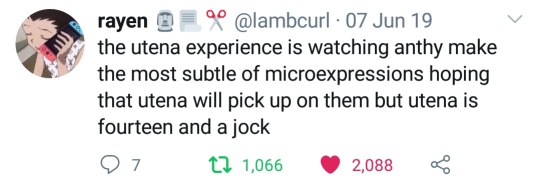Hi there :) This is mary34's blog. I mostly blog and reblog about anime, manga, vocaloid and other nerdy things. Warning: Spoilers everywhere!
Don't wanna be here? Send us removal request.
Text
James Somerton is working as a wedding photographer with a plagiarized portfolio, btw
YoutubeDrama thread where this came out.




He truly seems incapable of not passing off others work as his own.
10K notes
·
View notes
Text


Redrew an old picture for Sleepydiscord's most recent artgame! I was honestly intimidated to try redrawing this one because I still like it a lot, so I'm glad to see that I have actually improved in the five years since then. Although I do regret not going as bold with the coloured highlights as I did the first time around... (COMMISSIONS)
312 notes
·
View notes
Text

you're just a pretender up up up up shake shake shake it off up
37 notes
·
View notes
Text

Wasn’t gonna post this but I felt proud of the water😼
Time took: 5 hours and 19 minutes
Reblogs and likes are appreciated!
You can click on the photo for a clearer version!
48 notes
·
View notes
Text
Hey, oomfies! This Eid, let’s spread some more love to Gaza. Grassroots orgs there are doing incredible work despite the many limitations...getting food, meds, and shelter to families who’ve lost everything. Even a few bucks can make a real difference. Donate the cost of a coffee!
10K notes
·
View notes
Text
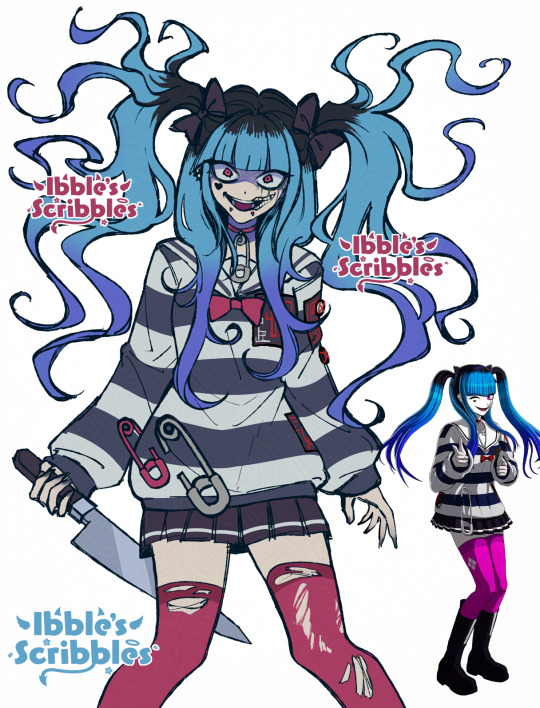
finally played the 100line demo and i think i could make her worse
206 notes
·
View notes
Text

Me when I'm throwing cheese slices at the local cybertuck
10K notes
·
View notes
Text
Has anyone done this yet

138 notes
·
View notes
Text
kind of obsessed with the angle of ave mujica being knights now if only because i KNOW umiri is taking that shit way too seriously. we need a kneeling knight emoji specifically for her.
86 notes
·
View notes
Text
BanG Dream! Ave Mujica (anime)
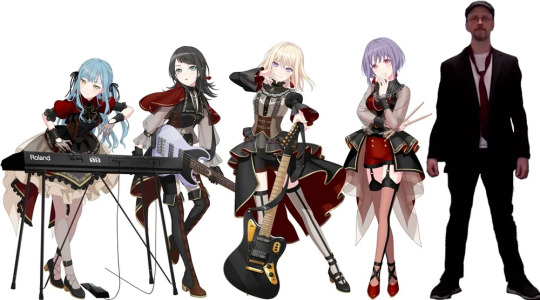
It's 2008, and Doug Walker is confused.
The famous film critic is doing a ten-year retrospective on Pokémon: The First Movie (1998). While watching the opening scene, in which a group of scientists explore a jungle, he poses a series of questions: "What are those things? Who are you? Where are we? What's that thing? Where am I? Is this Earth? Are we in another dimension? Is this the past? The future? The present? What's going on?! Where does this even take place?! Oh, my God, I'm, like, one minute into this movie, already I'm totally lost!"
To Walker's credit, Pokémon is a notoriously impenetrable narrative, known for its high complexity and thematic depth. As he explains: "For those of you who don't know what [Pokémon]'s about, I can't help you because nobody knew what the hell it was about. [...] Nobody could follow it. The only people who understood it at all were the kids."
A similar confusion descended upon me as, on the recommendation of several people in my orbit who called it the criminally underrated sleeper hit of the season, I watched the first episode of BanG Dream! Ave Mujica. They compared it to Umineko, Madoka Magica. None of them told me the show is a sequel (to 2023's BanG Dream! It's MyGO!!!!!), nor any other crucial bits of context: that plot details and twists have been foreshadowed via ARG; that there are music videos for the songs the show's band plays, themselves containing oblique hints to the narrative; that the band itself is real, not in the vtuber sense where rigged anime girls bob their heads on stream but in the sense that each character is voice acted by the members of a real five-person band called Ave Mujica that plays live shows in goth costumes.

Oh no, I thought. I've stepped into a bear trap!(!!!!)
My initial confusion mostly stemmed from the show expecting the audience to already know all the characters, not simply the five members of the band Ave Mujica but also the five members of the band MyGO!!!!!, who are the main focus of the predecessor series. There are few establishing shots, few immediate character beats that cause one character to stand out from the rest, and the character designs have the traditional sameface of idol anime, so hair and eye color are often the only notable aesthetic differences between them. I watch a lot of anime, and sameface doesn't usually throw me, but here it was a struggle to tell some characters apart (particularly Ave Mujica's two blonde guitarists, Uika and Mutsumi).
Disorientation can cause one to stop thinking at all, though, even to understand things that are perfectly understandable. The irony of Walker's baffled series of questions about the opening scene of the Pokémon movie is how most of them pertain to the setting, when the scene's setting (the real-world nation of Guyana) never appeared before or since in the franchise; even the most dedicated six-year-old had as much ability to answer questions about it as Walker himself. It's not even important, really, in the scope of the plot. It's a jungle somewhere, some distant land. It's in one scene and disappears forever. But Walker, like most parents of 1998, encountered a few details he couldn't understand (the franchise's foreign-sounding name, the endless array of unique monsters) and gave up trying to understand anything at all.
In Walker's defense, the most insidious aspect of confusion is not knowing what you don't know. A Pokémon fan watches that opening scene, well aware of the typical setting of Pokémon, and thus knows that this jungle setting is someplace new, some foreign locale, something they're not supposed to know. Walker cannot, at a glance, discern that. To him, maybe this jungle is the primary location where the action is set. Maybe he really is at a disadvantage for not being aware of it already.
The trick to understanding Ave Mujica is that the five members of MyGO!!!!! do not matter nearly as much as their screentime suggests. There is some connection, as two members of Ave Mujica (Sakiko and Mutsumi) were previously in a band (CRYCHIC) with three members of MyGO!!!!!, and Sakiko's abrupt and unexplained departure from CRYCHIC is the root of the interpersonal drama between Sakiko and Mutsumi. Otherwise, the MyGO!!!!!ites serve as outsiders to the main drama who look in and occasionally comment on it; not knowing anything about them is fine. Once I figured that out around Episode 3 or 4, the show became generally comprehensible.
I think.

It's 2019, and Doug Walker is confused.
Everyone is. A collective confusion as, during the climax of his avant garde musical reassessment of Pink Floyd The Wall (1982), an anthropomorphic mustelid slithers onto his shoulder while singing a Cockney rendition of "The Trial". Across a series of discombobulated fantasy landscapes, Walker has been regaled by this and several other digital creatures designed with an almost obscene attention to detail, lavish fur and fabric textures far beyond the pale of Walker's more workman-like VFX flair. If there was context, it has been lost in the characters' impenetrable accents and vocal layering. All anyone watching can do is ask:
What are those things? Who are you? Where are we? What's that thing? Where am I? Is this Earth? Are we in another dimension? Is this the past? The future? The present? What's going on?! Where does this even take place?!
Nobody can follow it...
Except Doug Walker. This isn't the reason he's confused. If anything, he is oddly, uncharacteristically accepting of the situation. He is a critic best known for animated facial expressions and wild gesticulations, but here he stands perfectly still almost the entire length of the song, even as the CGI creatures pluck his hat off his head or lift him bodily into the air or toss him into a little spike-studded Doug Cage. His face is stone.
No, this is a Walker who exhibits, at last, mastery over the raw facts of narrative. It is not plot, character, or setting that confuse Walker about The Wall. When he criticizes the song "Another Brick in the Wall Pt. 2", he correctly assesses that the song is about the cruelty of the education system. What he's confused about, lacking the cultural context of British grammar schools in the 1950s, is what this means, how to interpret it. He can only do so in the frame of the suburban American education system he remembers, and so ascribes to the song meaning relevant to that context; namely, that school isn't that bad, that teachers can be nice, and that anti-school youth sentiment is meaningless counterculture. It's a misunderstanding, not of fact, but of heart. "Pretentious," Walker calls it, a word he repeats across the video. Pretentiousness is a fixation of Walker's. He loves the word; he uses it often. It's perhaps the perfect word for a workman-like man like Doug Walker, one of the first true outsiders to achieve success in the democratized media landscape of the internet.
"Pretentious" means the author believes their work possesses more meaning and importance than the critic can derive from it.
This confusion of interpretation struck me too as I watched Ave Mujica, even when I understood on a summary level the plot and characters. In the first episode, one of the few characters to distinctively establish herself is Ave Mujica's drummer, Nyamu, who starts a catty argument with the band's keyboardist and founder, Sakiko. The crux of the argument is simple. Part of Ave Mujica's gimmick as an avant garde act that blends live music with acted skit segments is that its five members wear masks on stage, concealing their identities. Nyamu, in Walkeresque fashion, wants to dispense with this "pretension," claiming to be bored of it. Her true goal is mercenary; she believes, as the only band member who is not already established in the entertainment industry, that publicly associating herself with her more famous bandmates will elevate her personal profile.
Sakiko, for whom this project is an artistic venture of deep psychological importance, rejects her proposal. But Nyamu disregards her bandmates' wishes and forcibly unmasks them at the next concert anyway.
I understood the argument. What I didn't understand was how to feel about it, how interpret Nyamu's role in the story. In a vacuum, I could only imagine she was intended as the show's villain. She is vain, petty, a shameless social climber, self-absorbed, a YouTuber, and also the driver of the initial conflict that causes the other bandmates to spiral psychologically out of control. Beyond that, she is commercial. In my preconceived cultural understanding of "fiction about art," the sellout is the villain, and the person with legitimate artistic vision (in this case, Sakiko) is the hero. The rest of the first episode supports this reading: it focuses on Sakiko's perspective and home life in a way that lends her significant pathos, while Nyamu exists solely to cause her grief.
Yet the rest of the show does not support this reading. When a band member has a schizophrenic break a few episodes later, Sakiko is framed as the core cause, due to her demanding auteurism. Nyamu, who sparked the inciting incident, is never blamed, either by the other characters or by the narrative as she slips away, unregenerate, into a minor and isolated subplot. She never abandons or even interrogates her crass commercialism, and despite being the most replaceable member of the band and the least interconnected to the others' social circle (she appears, actually, to be a college-aged adult while everyone else is a high schooler), nobody suggests she be replaced when the band breaks up and reforms. Nobody demands anything of her at all. Nobody even really seems to see her as a problem.
I love it. I love it when shameless little shits don't get any comeuppance at all. I love Nyamu. (Honestly!)
But how am I supposed to interpret her argument, within the framework of Ave Mujica as a story?
The obvious interpretation is that Nyamu is correct, or at least in wake of the show's ambivalence toward her, not wrong. Cynical commercialism has value, is at least an important consideration for artistic decisions. This interpretation makes sense considering it's the artiste Sakiko who winds up shouldering the blame for the band's internal collapse, but at the same time it's a bizarre proclamation to make in a show that is otherwise so concerned with rendering Sakiko empathically, with exploring her psyche and motivations, and with -- ultimately -- selling the audience her artistry. Ave Mujica, as I explained, is a real band. All the goth flair, the arcane skits, the oblique narrative hints, and the doll symbolism that are core to Sakiko the character's artistic vision are also core to the real-life Ave Mujica the band. It's inconceivable to me that the show is actually dismissing its own aesthetic as "pretentious." Why, then, does its own in-universe Nyastalgia Critic go unchallenged, escape unscathed? What does it mean that these criticisms emerge not from unconnected outsiders (even with five members of MyGO!!!!! right there, with their significantly more down-to-earth, more workman-like band) but from one-fifth of Ave Mujica itself?
What, exactly, is Ave Mujica's identity?
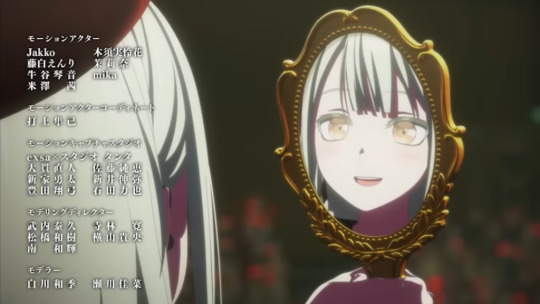

It's 2013, and Doug Walker is confused.
Existentially.
The video is titled "The Review Must Go On," with an ominous subtitle in the vein of End of Evangelion: "Demo Reel Finale." Something, indeed, is coming to an end here, and it isn't just Doug Walker's lifelong passion project.
In this postmodern künstlerroman, Doug Walker stares into a mirror, but what he sees is not Doug Walker. It is his past and it will be his future. (Is this the past? The future? The present? What's going on?!) It is the fixed and unchanging edifice of 18 long years and counting, an entity unstuck from time, who, despite changes to format, site, contemporary taste, and the internet itself, remains immutable. It cannot be denied, cannot be destroyed, can only -- briefly -- be bargained with.
And Doug Walker bargains. "Not every week," he says, staring his down his creation. "Once every two weeks." His creation, only somewhat put off, accedes. (Now, in 2025, it's once a week once more.) A single word: "Done," and the deal is made.
"Alright then," Walker says, with a beleaguered sigh. "What's next?"
The cold voice replies: "I think you know what's next."
Walker does know. He returns to his desk, where he had been typing the script to the Demo Reel Finale, and dutifully writes what he has known all along. Donnie DuPre, the main character of Demo Reel, that lifelong passion project, that original creative work, was always him.
The Nostalgia Critic.
It's a final surrender. There will be no more passion projects. No delusions of artistic accomplishment. None, at least, that don't involve this thing that Doug Walker has become, this thing to which he has given the rest of his life.
This moment mirrors the argument between Nyamu and Sakiko. Though Walker claims otherwise in the video, the decision to revive the Nostalgia Critic is clearly commercial; the Nostalgia Critic is popular, Demo Reel is not. Walker has abandoned his artistic vision in favor of what sells. Nyamu has won.
Except it's Sakiko, not Nyamu, who makes the demands that the Nostalgia Critic makes of Doug Walker. "I am not going to let this band be just a passing fad," Sakiko says. "I told you. Give me the rest of your life."
Doug Walker is giving the rest of his life to the Nostalgia Critic. Is trapped by it. As Ave Mujica progresses, its members become similarly ensnared. I claimed previously that Nyamu is never punished by the narrative, never challenged by the other band members or blamed for her actions, nobody ever attempts to get her replaced, but the opposite side of that coin is that she is incapable of getting herself replaced despite her desire to use the band as a stepping stone for a personal career. Though she gains industry connections via a bandmate's actress mother, she is crippled by the memory of one of Ave Mujica's most perplexing images, an image that similarly left me at an utter loss: the guitarist Mutsumi, collapsed in a disassociating stupor, on stage before an audience of thousands.
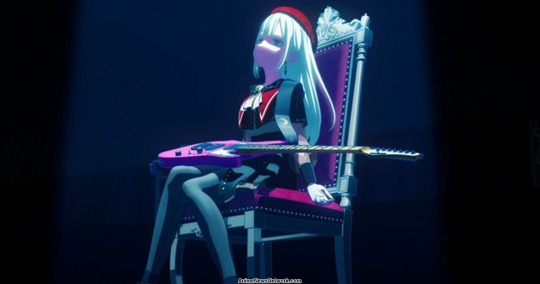
This moment is the beginning of Mutsumi's character arc, in which she is consumed by her band persona, Mortis, in a literalized split-personality storyline that itself has obvious parallels to Doug Walker's relationship with the Nostalgia Critic in The Review Must Go On. What fascinates me about this moment, though, is the reaction of everyone watching. The moment Mutsumi unexpectedly collapses, Sakiko deftly weaves it into the band's narrative, concocting a story about how the song they were playing lulls the "dolls" (Ave Mujica's band members) into eternal slumber, before abruptly ending the entire concert. The other four members step off the stage, leaving only the collapsed Mutsumi in the spotlight, motionless and silent.
The audience loves it. The band explodes in popularity. It's such a memetic event that the fans become disappointed when it isn't repeated at the next concert; Nyamu suggests that they repeat it, even to the point of showing up to concerts and not playing music at all. "Ignoring the audience's expectations -- what's the point of that?"
Nobody, in or out of the band, reads Mutsumi's collapse as a cry for help.
She can't cry for help. No matter what she does. When the band announces their breakup, she screams hysterically on the stage, even as the other four members are quiet. "Mutsumi was cooking until the end," a social media post later remarks. She has a breakdown on the street, arguing with her split personality in Gollum/Smeagol fashion (complete with camera angles swapping back and forth to indicate her two selves), and though people gather around and film it, the audience's only possible interpretation of the event is that it is a promotional stunt for the band. Even Nyamu, haunted by that image of Mutsumi collapsed in the chair, isn't haunted because of the psychological toll her actions inflicted on her bandmate (and, eventually, primary yuri shipmate), but because she believes Mutsumi was acting, acting so ingeniously that it torments Nyamu she cannot achieve that same level of skill.
Mutsumi is entrapped within the narrative ambiguity of Ave Mujica. Like Doug Walker, everyone watching her is confidently confused, only able to interpret her actions within their own contextual framework.
What is the contextual framework of Ave Mujica, though? It is a Babushka doll of meaning, an anime based on a real band that contains within it contradictory proponents of artistic vision and common-denominator commercialism, that is itself contradictorily artistic -- if my struggle to interpret it is enough to suggest -- and commercial, the way its poetic symbolism about dolls and control is draped on samefaced 3D anime girl models that move stiffly and unconvincingly. But the show is willing to make those 3D models contort their faces into distinctively un-idol-like (distinctively Doug Walker-like) maniacal expressions, to throw them on the ground and scrape open their knees with blood streaming out, to have them hurl each other down the stairs in fits of rage, to pair them in incestuous yuri couplings. The story both gesticulates toward a cynical, darker take on the idol industry like Perfect Blue or Oshi no Ko, yet is part of an established idol franchise selling these characters as actual idols. Even in the narrative, the depiction of the idol industry is confused; the band seems to have no managers, no agents, nobody telling them what to do. They don't even have secretaries; bassist Umiri handles scheduling and itineraries. Men only exist in the world of BanG Dream! as fathers or grandfathers; every behind-the-scenes staffer at the concerts, in fact every concertgoer, is female.
Nyamu is not Akane Yonezawa, Ave Mujica's real life drummer. But both are industry outsiders in their first real role, compared to their four bandmates who are already established. Rich girl keyboardist Sakiko is not Kanon Takao, but Kanon Takao was winning international piano tournaments in Milan at age 10. Where is the line between fiction and reality? How real is this anime, and how fake is this band? How much is the Nostalgia Critic a character, and how much is he Doug Walker with a hat?
And isn't it within this endless array of ambiguity, of questions, of confusion, that Ave Mujica ensnares? "Give me the rest of your life," Sakiko says, but with these ARGs and multimedia comb-over-it-with-a-magnifying-glass details and crossovers with other bands, whose life is she demanding? To the incurious, the Doug Walkers, confusion is enough to dismiss out of hand. But for those who want to know more, there are an endless amount of dolls to open...
Perhaps Walker was right, all those years ago in 2008, to not gaze too deeply into the world of Pokémon. It is a franchise, after all, that has exploited the human instinct toward curiosity to become the highest-selling media property of all time.
("Ignoring the audience's expectations -- what's the point of that?" Nyamu says.)

It's 2021, and Dan Olson is confused.
He is a critic criticizing a critic. In this case, he is criticizing Doug Walker's review of The Wall. Unbelievably, this criticism has over 2 million more views than Doug Walker's The Wall video does. Over twice as many people have seen this criticism than the thing being criticized.
Olson asks:
"What is this? Why does this exist?"
He doesn't know why Doug Walker would do this. Why would he put such elaborate effort into a musical review of The Wall, something Walker barely seems to understand or care about at all, something he only seems to have watched for the first time in preparation for creating the review. Walker's lack of curiosity baffles Olson, particularly because it is balanced against the effort on display in the review itself. How can someone spend months on costumes, visuals, parody lyrics, and celebrity guests, all to call something pretentious?
What Olson doesn't realize is that there is a Doug Walker, wannabe filmmaker, involved in this production, a Doug Walker with -- for better or for worse -- an artistic vision, who is willing to go to great lengths to apply that vision.
But someone else is running the show. Someone to whom Doug Walker has given the rest of his life. He's called the Nostalgia Critic, but, as in Ave Mujica, this avatar of commercial greed is only an abstraction, isn't it? A figment of ambiguity in which all cries for help, no matter how loudly they are screamed, can be extinguished. There's someone else, unseen and unacknowledged, with real control over these dolls, the one who forces them to perform as perfect time capsules, ageless and eternal. I'm not sure what they're called for Ave Mujica, but for Doug Walker, their name can be found with a bit of searching: Mike Michaud.
"Let me show you," says that anthropomorphic mustelid, Lucy Lacemaker, as the first notes of The Trial begin. "Let me show you what happens when your dreams no longer need you."
#reblog#long post#fave#ave mujca#bandori#not sure what to make of the use of doug walker as an extended metaphor for the series#but I am deeply fascinated by this post#reblogging mainly so i can find it later#and read the whole thing again on a rainy day
70 notes
·
View notes
Text

I feel like I put more effort into this drawing than any other I've ever done lmao. Btw look how cute are these knights with their lords 👉👈
297 notes
·
View notes




